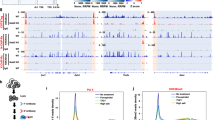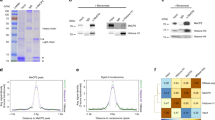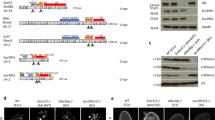Abstract
The ets-related gene erg encodes a transcription factor that is implicated in the control of cell growth and differentiation. To identify interacting partners of ERG, we screened a yeast two-hybrid cDNA library constructed from mouse hematopoietic cells using the N-terminal region of ERG as a bait. We isolated a 4.6 kb full-length mouse cDNA encoding a 1307-amino acid protein migrating as a 180 kD band, which was termed ESET (ERG-associated protein with SET domain). ESET is 92% identical to the human protein SETDB1 (SET domain, bifurcated 1). The interaction between ESET and ERG was supported by in vitro pull-down using glutathione S-transferase (GST) fusion protein, by transfection and co-immunoprecipitation experiments, and by association of endogenous SETDB1 with ERG. Since ESET possesses evolutionarily conserved SET, preSET, and postSET domains implicated in histone methylation, we tested the ability of ESET to methylate core histones. The results of these studies demonstrated that ESET is a histone H3-specific methyltransferase, and that mutations within ESET abolished its methyltransferase activity. Together, these findings raise the possibility that transcription factor ERG may participate in transcriptional regulation through ESET-mediated histone methylation.
This is a preview of subscription content, access via your institution
Access options
Subscribe to this journal
Receive 50 print issues and online access
$259.00 per year
only $5.18 per issue
Buy this article
- Purchase on Springer Link
- Instant access to full article PDF
Prices may be subject to local taxes which are calculated during checkout




Similar content being viewed by others
References
Aletta JM, Cimato TR, Ettinger MJ . 1998 Trends Biochem. Sci. 23: 89–91
Bird AP, Wolffe AP . 1999 Cell 99: 451–454
Bannister AJ, Zegerman P, Partridge JF, Miska EA, Thomas JO, Allshire RC, Kouzarides T . 2001 Nature 410: 120–124
Buhler D, Raker V, Luhrmann R, Fischer U . 1999 Hum. Mol. Genet. 8: 2351–2357
Chen D, Ma H, Hong H, Koh SS, Huang SM, Schurter BT, Aswad DW, Stallcup MR . 1999 Science 284: 2174–2177
Dunn T, Praissman L, Hagag N, Viola MV . 1994 Cancer Genet Cytogenet. 76: 19–22
Giovannini M, Biegel JA, Serra M, Wang JY, Wei YH, Nycum L, Emanuel BS, Evans GA . 1994 J. Clin. Invest. 94: 489–496
Hahn SL, Wasylyk B, Criqui-Filipe P, Criqui P . 1997 Oncogene 15: 1489–1495
Harte PJ, Wu W, Carrasquillo MM, Matera AG . 1999 Cytogenet. Cell. Genet. 84: 83–86
Ichikawa H, Shimizu K, Hayashi Y, Ohki M . 1994 Cancer Res. 54: 2865–2868
Im YH, Kim HT, Lee C, Poulin D, Welford S, Sorensen PH, Denny CT, Kim SJ . 2000 Cancer Res. 60: 1536–1540
Kozak M . 1991 J. Biol. Chem. 266: 19867–19870
Lachner M, O'Carroll D, Rea S, Mechtler K, Jenuwein T . 2001 Nature 410: 116–120
Leprince D, Gegonne A, Coll J, de Taisne C, Schneeberger A, Lagrou C, Stehelin D . 1983 Nature 306: 395–397
Li R, Pei H, Watson DK . 2000 Oncogene 19: 6514–6523
Nomura N, Nagase T, Miyajima N, Sazuka T, Tanaka A, Sato S, Seki N, Kawarabayasi Y, Ishikawa K, Tabata S . 1994 DNA Res. 1: 223–229
Nunn MF, Seeburg PH, Moscovici C, Duesberg PH . 1983 Nature 306: 391–395
Ponting CP . 1997 Trends Biochem. Sci. 22: 51–52
Prasad DD, Ouchida M, Lee L, Rao VN, Reddy ES . 1994 Oncogene 9: 3717–3729
Rao VN, Papas TS, Reddy ES . 1987 Science 237: 635–639
Raouf A, Seth A . 2000 Oncogene 19: 6455–6463
Rea S, Eisenhaber F, O'Carroll D, Strahl BD, Sun ZW, Schmid M, Opravil S, Mechtler K, Ponting CP, Allis CD, Jenuwein T . 2000 Nature 406: 593–599
Sorensen PH, Lessnick SL, Lopez-Terrada D, Liu XF, Triche TJ, Denny CT . 1994 Nat. Genet. 6: 146–151
Strahl BD, Allis CD . 2000 Nature 403: 41–45
Tachibana M, Sugimoto K, Fukushima T, Shinkai Y . 2001 J. Biol. Chem. 20: 20–
Trojanowska M . 2000 Oncogene 19: 6464–6471
Tschiersch B, Hofmann A, Krauss V, Dorn R, Korge G, Reuter G . 1994 EMBO J. 13: 3822–3831
Wu DY, Kalpana GV, Goff SP, Schubach WH . 1996 J. Virol. 70: 6020–6028
Yang L, Embree LJ, Hickstein DD . 2000 Mol. Cell. Biol. 20: 3345–3354
Zucman J, Melot T, Desmaze C, Ghysdael J, Plougastel B, Peter M, Zucker JM, Triche TJ, Sheer D, Turc-Carel C . 1993 EMBO J. 12: 4481–4487
Acknowledgements
We thank Dr Thomas Jenuwein for the myc-SUV39h1 plasmid. This work is supported in part by funds from the Department of Orthopedics and Sports Medicine at the University of Washington and by a New Investigator Grant from the Leukemia Research Foundation (to L Yang). Y Zhang is a V-foundation scholar and work in his lab is supported by NIH (GM63067-01) and ACS (RSG-00-351-01-GMC).
Author information
Authors and Affiliations
Corresponding author
Rights and permissions
About this article
Cite this article
Yang, L., Xia, L., Wu, D. et al. Molecular cloning of ESET, a novel histone H3-specific methyltransferase that interacts with ERG transcription factor. Oncogene 21, 148–152 (2002). https://doi.org/10.1038/sj.onc.1204998
Received:
Revised:
Accepted:
Published:
Issue Date:
DOI: https://doi.org/10.1038/sj.onc.1204998
Keywords
This article is cited by
-
SETDB1 promotes progression through upregulation of SF3B4 expression and regulates the immunity in ovarian cancer
Journal of Ovarian Research (2024)
-
The functions of SET domain bifurcated histone lysine methyltransferase 1 (SETDB1) in biological process and disease
Epigenetics & Chromatin (2023)
-
Loss of H3K9 trimethylation alters chromosome compaction and transcription factor retention during mitosis
Nature Structural & Molecular Biology (2023)
-
SETDB1 interactions with PELP1 contributes to breast cancer endocrine therapy resistance
Breast Cancer Research (2022)
-
Establishment of H3K9-methylated heterochromatin and its functions in tissue differentiation and maintenance
Nature Reviews Molecular Cell Biology (2022)



